Written by: Tanay Ved
Compiled by: Saoirse, Foresight News
Key Points
Digital asset reserves focusing on Ethereum are rapidly expanding, having accumulated 2.2 million ETH (1.8% of total supply) in just two months, causing a supply-demand imbalance.
These funds adopt proactive on-chain strategies, planning to allocate funds through staking and DeFi while improving yields and supporting network security and liquidity.
Although still in the accumulation phase, higher on-chain participation may enhance Ethereum's liquidity and security while increasing its exposure to corporate funding risks.
The Rise of Digital Asset Reserves
Digital Asset Treasuries (DATs), referring to publicly traded companies that hold cryptocurrencies like Bitcoin or Ethereum on their balance sheets, have become a new market entry channel. The launch of spot ETFs in 2024 has released demand from investors who previously could not hold BTC and ETH through direct custody. Similarly, digital asset treasuries provide investors with opportunities to access these assets and their ecosystems through publicly traded stocks and have the strategic capability to raise and allocate funds.
We have previously analyzed Michael Saylor's (strategy manual), which raised funds through issuing stocks and convertible bonds, accumulating over 628,000 Bitcoins (2.9% of total Bitcoin supply). Numerous companies globally are following suit, from Marathon Digital to Japan's Metaplanet, all providing shareholders with amplified or 'leveraged' Bitcoin exposure. Now, this model is expanding to other ecosystems, with many entities competing to increase their ETH holdings in corporate treasury reserves.
Although the goal of increasing shareholder exposure to underlying assets remains unchanged, the Ethereum reserve differs fundamentally from Bitcoin reserves: the former can leverage Ethereum's staking and DeFi ecosystem. This creates the potential to enhance returns through the effective allocation of Ethereum's native yields and on-chain capital. In this article, we will analyze the dynamic impact of Ethereum reserves on Ethereum's supply and explore the possible effects of these large institutions entering on-chain.
Supply Dynamics: The Race for 5% of Supply
Since July this year, Ethereum digital asset reserves have accumulated to 2.2 million ETH, accounting for nearly 1.8% of the current total ETH supply. There are currently five major participants in this field, raising funds through methods such as public offerings or private equity (PIPE) of listed companies, to allocate capital and enhance the value of their held assets. As of August 11, the holdings of these entities are as follows:
Bitmine Immersion Technologies: 1.15 million ETH, worth approximately $4.8 billion
SharpLink Gaming: 520,000 ETH, worth approximately $2.2 billion
The Ether Machine: 345,000 ETH, worth approximately $1.4 billion
Bit Digital: 120,000 ETH, worth approximately $503 million
BTCS Inc.: 70,000 ETH, worth approximately $293 million
Bitmine Immersion Technologies is currently the largest corporate holder of ETH, with holdings accounting for 0.95% of total ETH supply, and is rapidly moving towards a goal of accumulating 5% of circulating supply. As market conditions change, these companies are able to build reserves on favorable cost bases, and the competition for a larger share of ETH is intensifying.
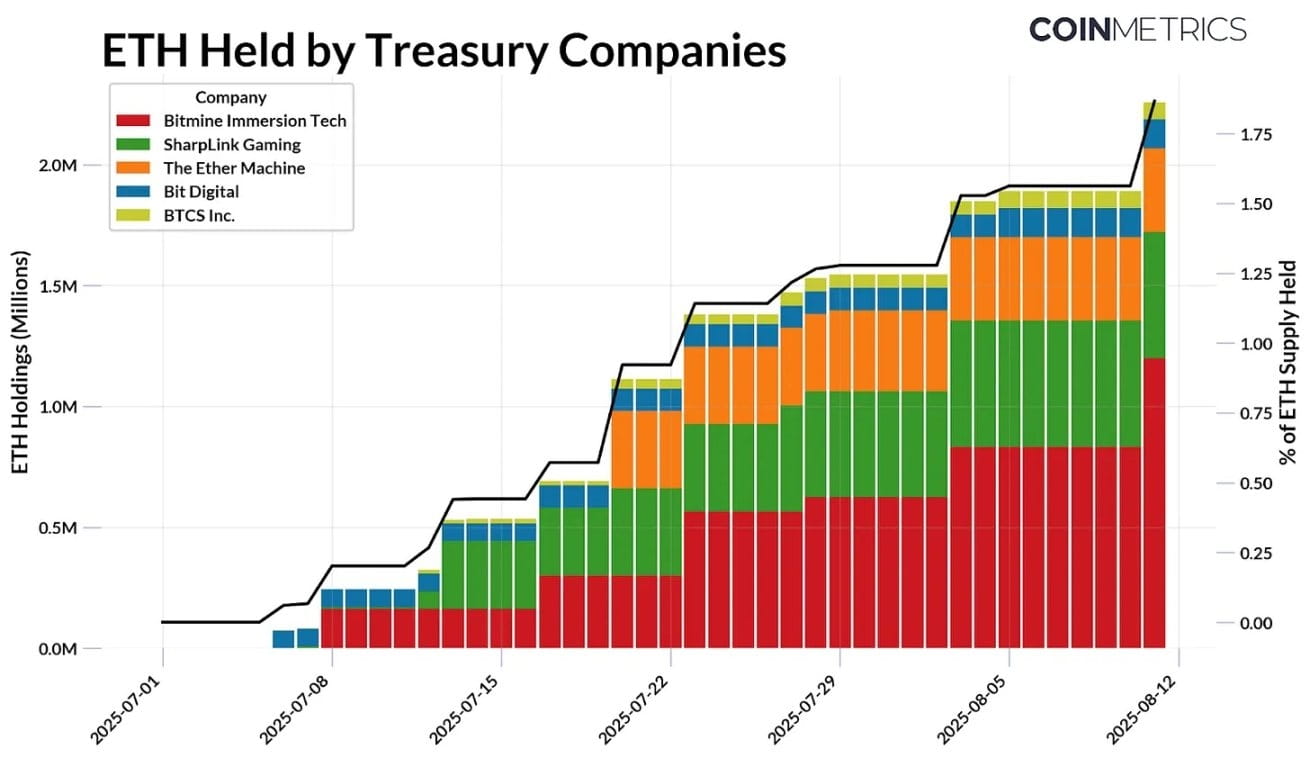
Source: Coin Metrics Network Data Pro and public documents (as of August 11, 2025)
Considering the issuance dynamics of Ethereum, this trend becomes more significant. The supply of Ethereum is regulated by the PoS mechanism, with newly issued ETH being allocated to validators, while some transaction fees are burned, thus the net issuance may fluctuate between negative (deflation) and positive (inflation) values.
Since the 'Merge' in September 2022, Ethereum has issued a total of 2.44 million ETH, burned 1.98 million ETH, and net issued 454,300 ETH. Since July this year, Ethereum treasury companies have cumulatively increased their holdings by 2.2 million ETH, far exceeding the net issuance during the same period. The supply cap and halving mechanism of Bitcoin directly reduce its new issuance, while Ethereum's supply is dynamic and currently in an inflationary state. Given that Ethereum's market capitalization is approximately 1/4.5 of Bitcoin's, the scale and speed of recent demand are even more notable.
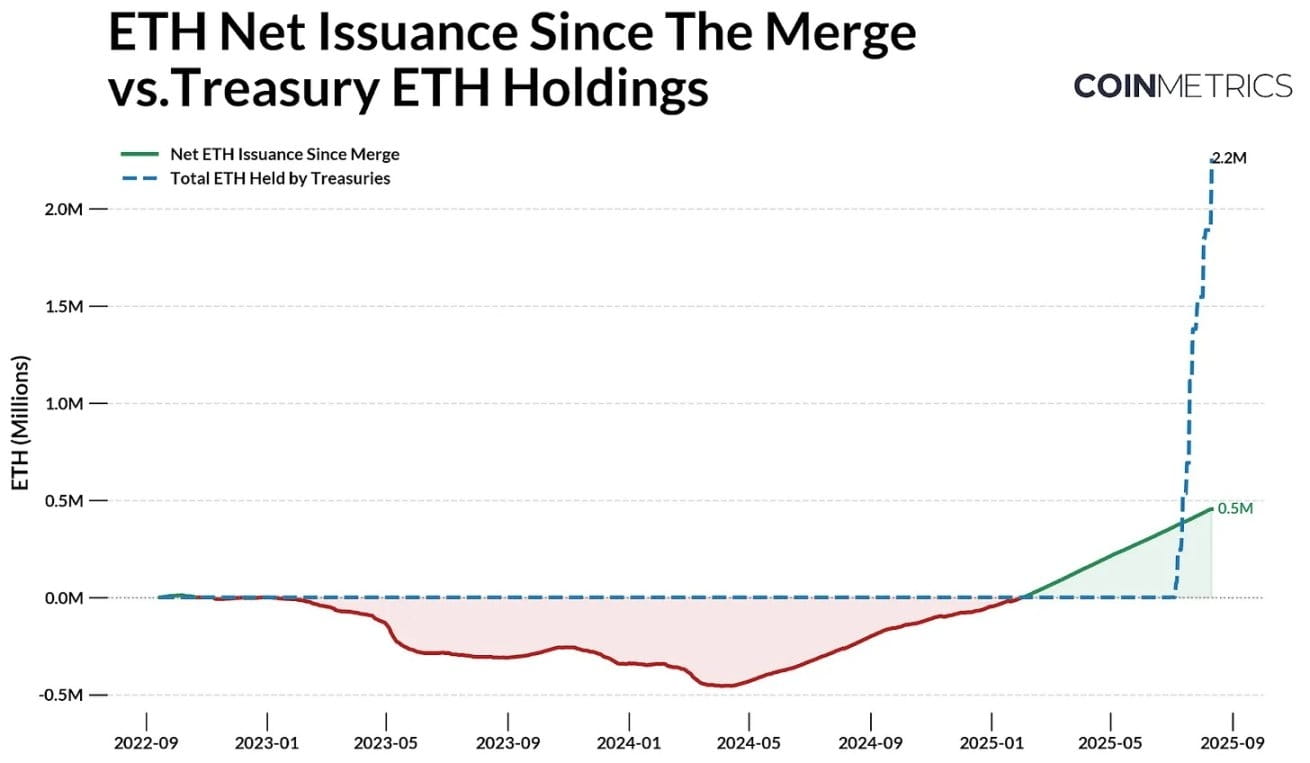
Source: Coin Metrics Network Data Pro and public documents
Given the recent increase in funds flowing into Ethereum ETFs, this supply-demand imbalance is becoming more pronounced. Overall, apart from the 29% ETH staked at the consensus layer and the 8.9% ETH held in other smart contracts, these tools continue to absorb Ethereum's 107.2 million free circulating supply (market available supply). Therefore, the continued accumulation of reserves and ETFs may amplify the price's sensitivity to new demand.
Ecosystem Impact: Staking, DeFi, and On-Chain Activities
Although most ETH treasuries remain in the accumulation phase, some of their funds may eventually enter on-chain. Unlike the relatively passive approach of Bitcoin treasuries, these companies plan to leverage Ethereum's staking and DeFi infrastructure to improve risk-adjusted returns and effectively utilize their held assets. This shift is already underway: SharpLink Gaming is staking the majority of its held assets, BTCS Inc. is generating returns through Rocket Pool, and other companies like The Ether Machine and ETHZilla are also preparing for more proactive on-chain management.
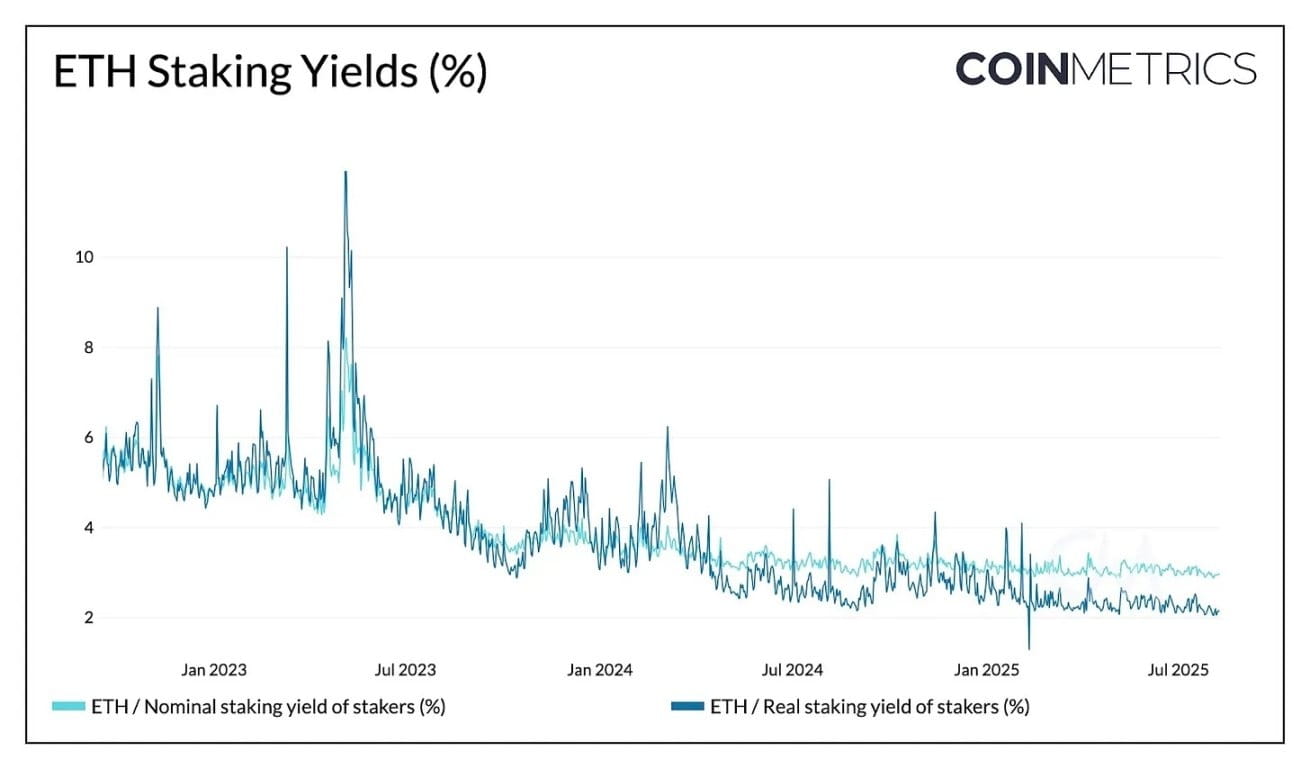
Source: Coin Metrics Network Data Pro
Currently, by providing staking rewards for network security, Ethereum can offer a nominal yield of 2.95% and a real (inflation-adjusted) yield of 2.15%. This not only brings price appreciation to the underlying assets but also provides treasury companies with a stable income stream. For instance, if 30% of the 2.2 million ETH currently held by treasury companies is staked at the current nominal yield of about 3%, with ETH priced at $4000, this could generate approximately $79 million in annual revenue. Although substantial inflows into staking may depress yields, the effect is relatively mild since Ethereum's reward rate gradually decreases as the total amount staked increases.
Corporate treasuries primarily participate in two ways: by running their own validator nodes or by utilizing liquid staking protocols. The U.S. SEC has clarified that liquid staking protocols are not considered securities, allowing companies to stake through third-party institutions such as Lido, Coinbase, or RocketPool and receive 'liquidity' token certificates in return.
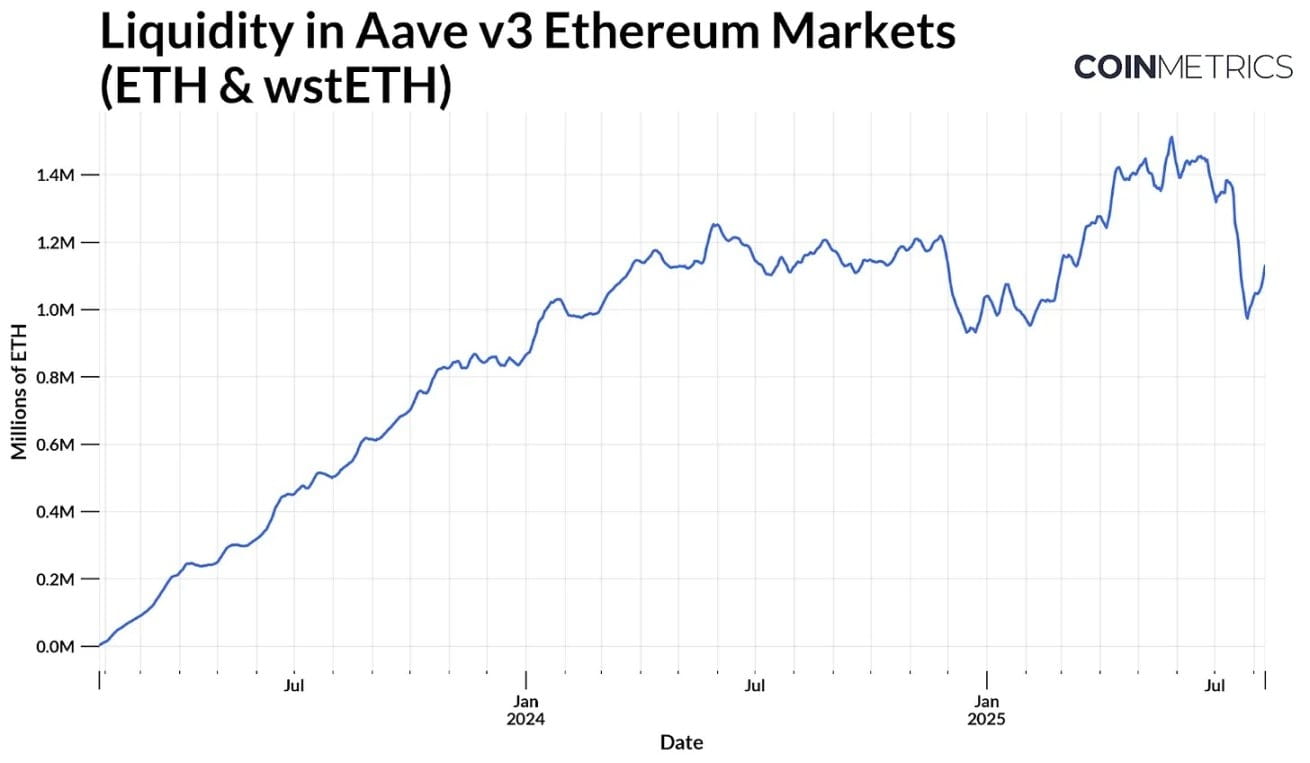
Source: Coin Metrics ATLAS
Despite additional risks, tokens like Lido's stETH are widely used in DeFi for staking lending or to gain additional yields on top of the benchmark staking annual yield in a capital-efficient manner. Taking Aave v3 as an example, ETH and liquid staking tokens like stETH constitute a huge available liquidity pool (the supply of assets available for lending). This pool has now grown to about 1.1 million ETH, and the addition of reserve funds may further expand the pool's size while enhancing market liquidity.
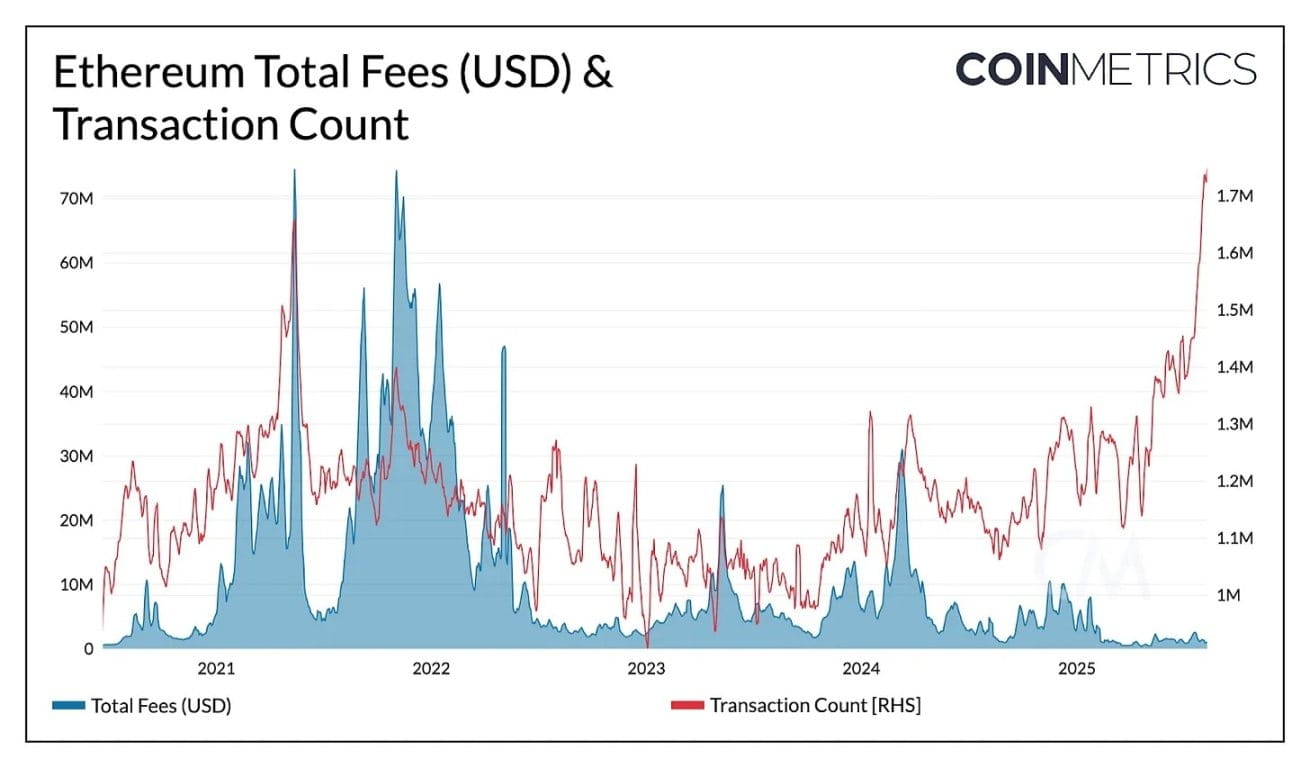
Source: Coin Metrics Network Data Pro
Although Ethereum's mainnet transaction volume has now surpassed historical records (1.7 to 1.9 million transactions daily), the recent increase in gas limits and block capacity expansion has alleviated network congestion and diverted some activities to L2, keeping total fees at a low level for years. If treasury company funds enter on-chain en masse, high-value transactions on Ethereum L1 could drive overall demand for block space and fee revenue, potentially creating a positive feedback loop among treasury activities, liquidity, and on-chain usage.
Linking corporate treasury performance to on-chain health status
As publicly listed Ethereum treasury companies expand their on-chain presence, their financial performance increasingly impacts Ethereum's long-term network health and links off-chain corporate performance with potential on-chain effects. Large-scale long-term holdings can reduce circulating supply, enhance recognition, and increase on-chain liquidity, but centralization, leverage, and operational risks mean that issues at the corporate level may transmit to the network.
Impact of Large ETH Reserve Holdings on On-Chain
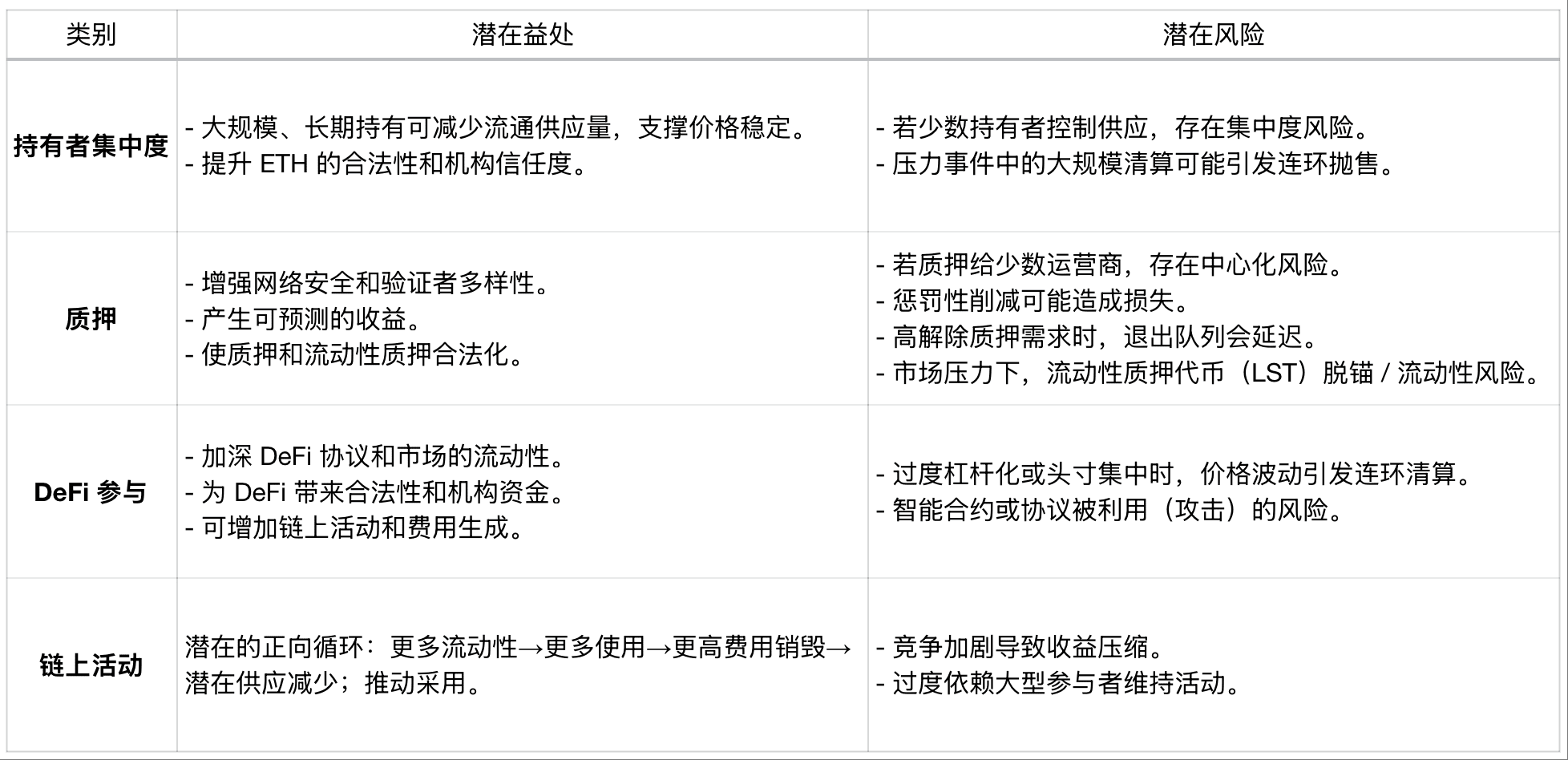
Although these are network-level considerations, corporate treasuries themselves are also influenced by market forces and investor sentiment. A strong balance sheet and sustained investor confidence can allow reserves to expand holdings and increase participation. Conversely, a significant drop in the price of underlying assets, tightening liquidity, or over-leveraging may lead to ETH sell-offs or reduced on-chain activity.
Indicators related to treasury company performance
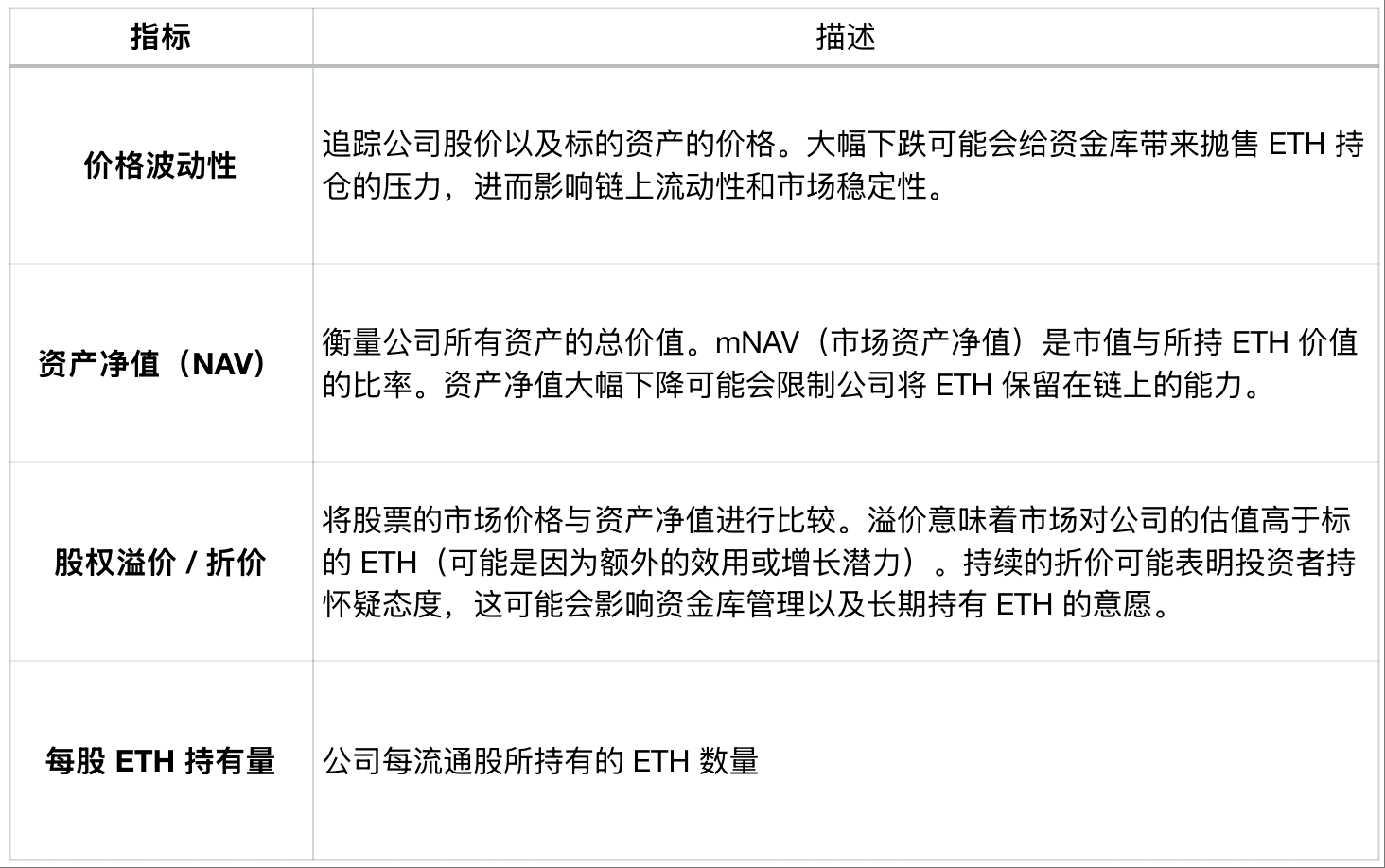
Indicator Description Price Volatility Tracks company stock prices and the prices of underlying assets. A significant drop may pressure the treasury to sell ETH holdings, thereby affecting on-chain liquidity and market stability. Net Asset Value (NAV) measures the total value of all company assets. mNAV (Market Asset Value) is the ratio of market capitalization to the value of held ETH. A sharp decline in NAV may limit a company's ability to keep ETH on-chain. Equity Premium/Discount compares the market price of the stock with the net asset value. A premium indicates that the market values the company higher than the underlying ETH (possibly due to additional utility or growth potential). A persistent discount may indicate skepticism from investors, which could affect treasury management and the willingness to hold ETH long-term. ETH Holdings Per Share The amount of ETH held by each share of the company.
By tracking the network-level impact and the financial health of these companies, market participants can better predict the potential effects of corporate treasury behavior on Ethereum's supply dynamics and overall network health.
Conclusion
The rapid rise of corporate Ethereum treasuries reflects the attractiveness of Ethereum as a reserve asset and on-chain revenue source. Its growing influence may enhance liquidity and active network activities, but it also comes with risks associated with leverage, financing, and capital management. As off-chain factors (such as stock performance, debt repayment) become increasingly connected to on-chain activities, these factors may quickly impact on-chain dynamics. As these institutions grow in scale, tracking their balance sheet health and on-chain activities will be key to understanding their impact.



